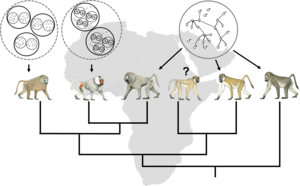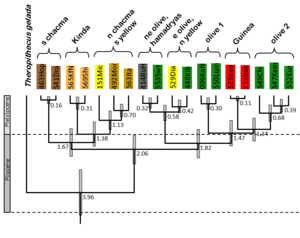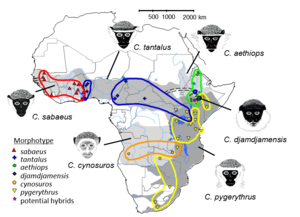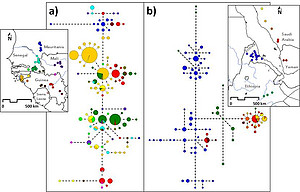Phylogenetic Analyses

Comparative phylogenetic methods are commonly used to investigate the evolution of primate adaptations including behaviour. Therefore it is crucial to establish robust phylogenies to directly incorporate the evolutionary history of a species into behavioural analyses. Furthermore, behaviour is not only influenced by genes but in turn can also shape the genetic structure of natural populations. Investigating this link is of great importance, because the alterations of genetic diversity induced by behavioural processes affect the material that evolution acts on. In this context gene flow between pop-ulations and species (hybridization) was found of particular importance in primate evolution.
Selected Projects
Baboon phylogeography

- Mitochondrial phylogeny of baboons revealed paraphyletic relationships
- Divergence age estimates suggest an early S/N split, followed by an E/W split of northern populations
- Splits correspond to Pleistocene climate changes and expansion of the savanna biome (Ziner et al. 2009, Keller et al. 2010, Zinner et al.. 2013)
Hybridization in green monkeys

- Mitochondrial phylogeny and morphotype distribution indicate para- and polyphyletic relationships (Haus et al. 2013)
- Comparison of mitochondrial- and Y-chromosomal DNA supports introgressive hybridization (Haus et al. in revision)
- Influence of hybridization on speciation and intra-specific genetic diversity
Baboon population genetics

- Does population genetic structure reflect differences in social systems?
- Do differences in the social organization influence gene flow between species?
- Major differences in genetic structure between baboon species with contrasting social systems (Kopp et al. under review)
Methods
- Non-invasive collection of fecal samples of wild primates
- Sampling of museum specimens
- Genetic analyses (genotyping, sequencing)
- Inference of phylogenies and population structure
- Relatedness estimates
- Determination of the degree and processes of hybridization
Collaborations
- Local authorities and universities in range countries
- Primate Genetics Laboratory (DPZ)
